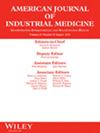Emergency department visits for heat-related illness among workers: Occupational health surveillance using Washington syndromic surveillance data
Abstract
Background
Information on worker occupation and industry is critical to understanding the occupational risks of heat-related illness (HRI), yet few syndromic surveillance systems capture these key data elements. This study evaluates the work data reported through Washington syndromic surveillance for its utility in characterizing HRI ED visits by industry and occupation.
Methods
Standard industry and occupation codes were assigned to employer name and occupation descriptions reported in Washington ED visit records maintained within the state's syndromic surveillance system, for visits involving HRI in 2020–2022. HRI ED visits involving workplace heat exposure were identified based on discharge diagnoses or on keywords in the triage note or chief complaint fields. HRI ED visits were summarized by patient characteristics, and visit rates were calculated by industry and occupation.
Results
Employer name or occupation descriptions were reported in 21.5% of HRI ED records among patients age 16 and older, and in 41.2% of records with mention of heat exposure at work. Twice as many records were classified for industry as for occupation. Agriculture, forestry, fishing, and hunting and transportation and warehousing had the highest rates of HRI ED visits. Specific industries with the highest rates included support activities for agriculture and forestry, the postal service, and fruit and vegetable preserving and specialty food manufacturing.
Conclusion
Syndromic surveillance data are a valuable source of occupational health surveillance information when work characteristics are reported, enhancing our understanding of the occupational risks of injuries and illnesses.

 求助内容:
求助内容: 应助结果提醒方式:
应助结果提醒方式:


